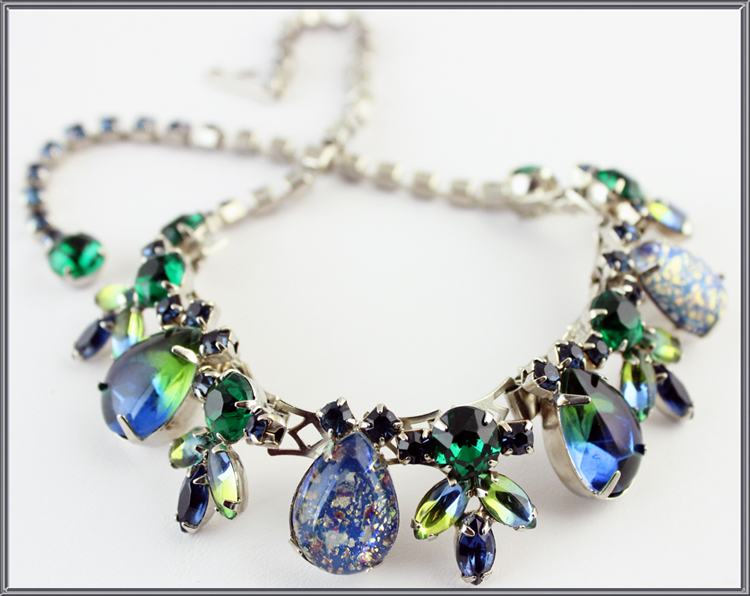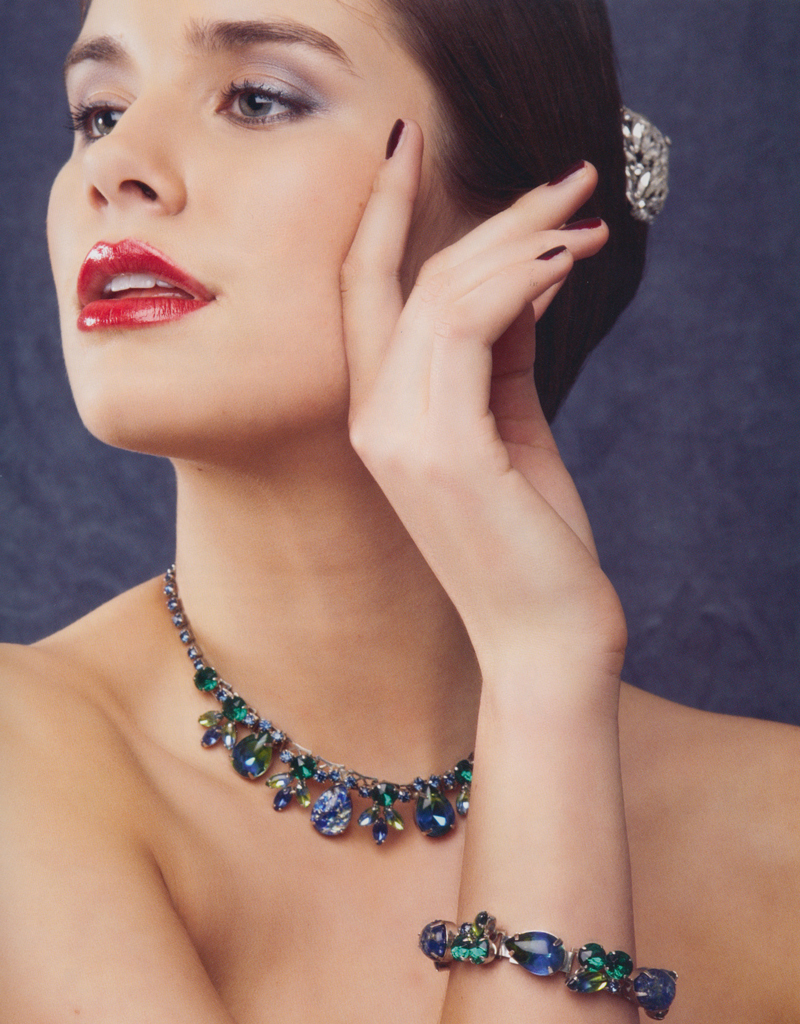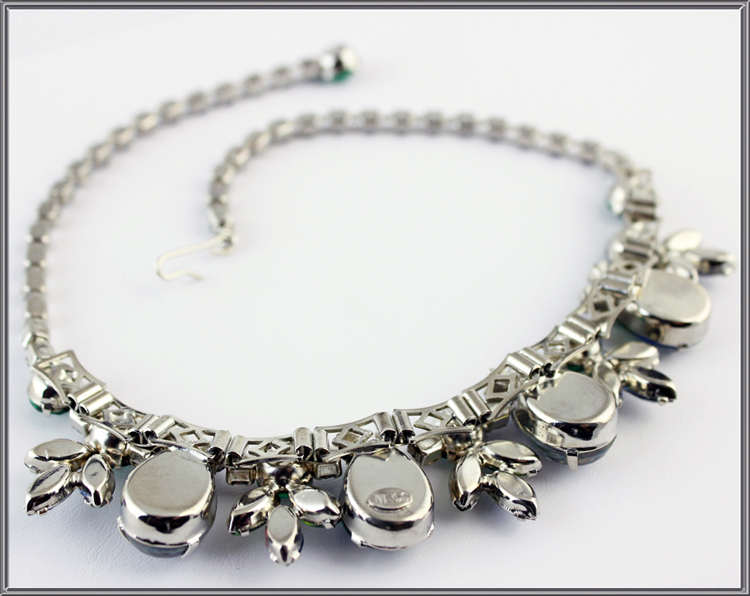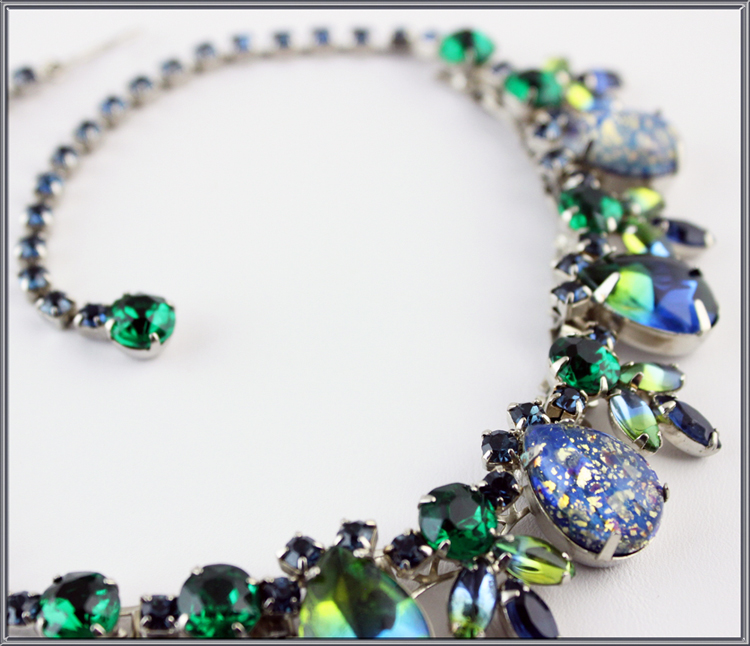Return To Previous Page
Weiss | *Book Piece* Necklace of Givré Navettes, Chatons and Foiled Art Glass
Weiss | *Book Piece* Necklace of Givré Navettes, Chatons and Foiled Art Glass
. . . . Exquisite!
Weiss
BOOK PIECE Weiss Necklace w/Givré Navettes Chatons & Foiled Art Glass Cabochons. I completely agree with the author, Judith Miller, of "Costume Jewelry", that Weiss jewelry was some of the most underrated rhinestone jewelry of the post-World War II period. There is no denying a custom crafted piece by Weiss—skillfully presenting its Austrian crystal rhinestones of exceptional clarity and color in handcrafted designs. This lovely necklace is no exception! Judith Miller chose this piece, along with its matching bracelet,to showcase for her beautifully done book, "Miller's Costume Jewelry". I can highly recommend the book if you are interested in books about collecting vintage jewelry. Her photos are excellent and there is also quite a bit of good information. That is probably my number one complaint about some of the books available on vintage jewelry is that the photography is terrible, but this book does not disappoint.
The necklace is in lovely condition and is truly a beauty! The silver tone metal is in good shape and you will notice the odd framework of this necklace. Out of all the Weiss pieces that have gone through my hands this was the first time I've seen this construction. The blue and green Givré Navettes are the perfect complement to the gorgeous Foiled Art Glass stones. Both are complemented with a sprinkling of Emerald Green and Sapphire Chatons.
Measurements:
Necklace — Approximately 16 inches long
Weiss Jewelry History —
Albert Weiss founded his company in New York in 1942. Prior to that, he worked for a long time in the company of Coro and therefore knew a lot about jewelry. Weiss imported rhinestone from Austria, created ornaments by hand. The design and quality were on top, and because of it, many ladies began to change such loud brands as Dior, Chanel, Haskell to jewelry from Weiss. So, the company started to grow and in just a few years has become very popular. To keep up to carry out orders, the company opened a production in Germany, France, and Rhode Island. Later, Weiss Jewelry Company was handed over to his son Michael, but he could not maintain its relevance in the market and in 1971 the company ceased to exist. Today jewelry by Albert Weiss enjoys unprecedented popularity among the fashionistas and lovers of vintage.
Weiss incorporated many styles and designs that were subsequently copied by other jewelers. Amongst the more desirable collector pieces are the 'black diamond' series which featured a unique smoky-colored rhinestone. Other popular pieces include those made with inverted rhinestones and series using a Christmas tree design.
Weiss went on to become a hugely successful costume jewelry designer in the 1950's and 1960's. Weiss' look was based more on paste than on metalwork, and indeed the settings became no more than a mere mechanism for displaying as many rhinestones as could possible fit on a single piece; his use of inverted stones and long stemmed enamel flowers with great detail, (they were produced in a range of colors and each with subtle differences in the stems, leaves, and petals), and his use of Pave icing meant to imitate Eisenberg designs.
Weiss gave much importance to the quality of his stones and got many of his supplies from Austria, since these stones had a higher lead content and gave his pieces a particularly dazzling appeal. His company was small but grew steadily so that in the 1950's and 1960's Weiss had to contract work out to be manufactured by Hollycraft, in order to keep up with the demand.
Weiss' own signature is the "black diamond" in smoky grey paste, which was the reproduction of the German smoky quartz crystals. Weiss based these unique stones on grey Austrian crystals, and they went on to become best sellers, widely copied by competitors in the 1950's.
Although, Weiss's work was mainly abstract, he also produced a limited range of figurals such as butterflies, insects, fruits and flowers. Weiss's first pieces were signed "Weiss", either on an applied plate or stamped directly into the metal, also "Weiss" in script. They were also signed "Albert Weiss" or A.W. Co., a signature that appeared sometime in 1951.
Weiss Jewelry had its own production and its own lines. It was affordable because of its low end popularity; Weiss also produced some high end costume jewelry
Weiss produced some of the most beautiful and quality jewelry of the time. Although not as large as some of the other costume jewelry designers like Trifari and Coro, their standard of craftsmanship was exceptionally high. Albert Weiss retired in 1969 leaving the directorship of the company to his son Michael. The popularity of the company continued for several years but finally Weiss Jewelry closed its doors in 1971.
Book: by Judith Miller [2010] —
Miller's Costume Jewelry, Octopus Publishing Group Ltd., London — Weiss: [Page 110].
Having trouble with the small sizes of
yesteryear? Well, most of us do!
The ladies were smaller than the women of today.
NO Problem, be sure to check out our necklace extenders.
The ladies were smaller than the women of today.
NO Problem, be sure to check out our necklace extenders.




